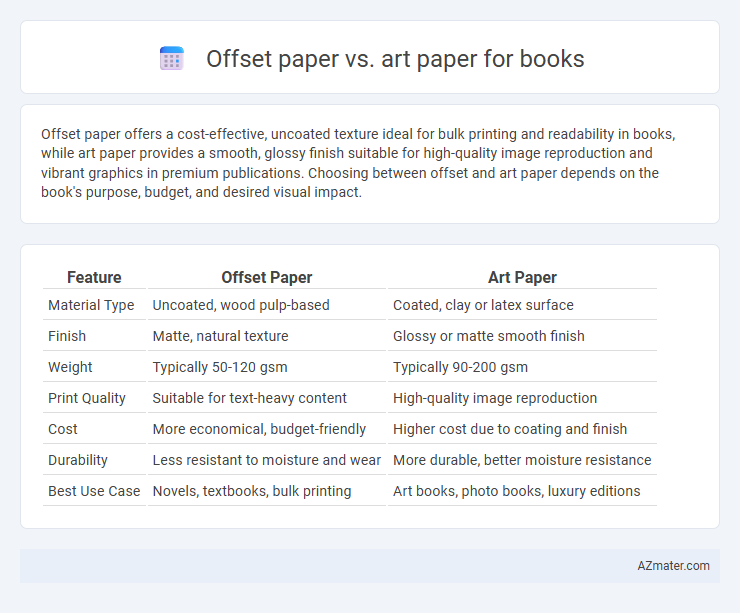Offset paper offers a cost-effective, uncoated texture ideal for bulk printing and readability in books, while art paper provides a smooth, glossy finish suitable for high-quality image reproduction and vibrant graphics in premium publications. Choosing between offset and art paper depends on the book's purpose, budget, and desired visual impact.
Table of Comparison
| Feature | Offset Paper | Art Paper |
|---|---|---|
| Material Type | Uncoated, wood pulp-based | Coated, clay or latex surface |
| Finish | Matte, natural texture | Glossy or matte smooth finish |
| Weight | Typically 50-120 gsm | Typically 90-200 gsm |
| Print Quality | Suitable for text-heavy content | High-quality image reproduction |
| Cost | More economical, budget-friendly | Higher cost due to coating and finish |
| Durability | Less resistant to moisture and wear | More durable, better moisture resistance |
| Best Use Case | Novels, textbooks, bulk printing | Art books, photo books, luxury editions |
Introduction to Offset Paper and Art Paper
Offset paper is a high-quality, uncoated paper commonly used in mass printing for books, known for its excellent ink absorption and cost-efficiency. Art paper, often coated with a glossy or matte finish, offers superior brightness and smooth texture, enhancing image clarity and color vibrancy in printed illustrations. Choosing between offset and art paper depends on the desired aesthetic and durability, with offset paper favored for text-heavy content and art paper preferred for visually rich pages.
Key Differences Between Offset and Art Paper
Offset paper is typically uncoated, more porous, and designed for high-volume printing methods that prioritize cost-effectiveness and durability, making it ideal for text-heavy books. Art paper, often coated with a smooth or glossy finish, offers superior brightness and sharpness, enhancing image reproduction and color vibrancy, which is essential for art books or photo-rich publications. The key differences between offset and art paper lie in coating, texture, print quality, and intended use, with offset paper favoring economy and readability and art paper focusing on visual impact and detail.
Surface Texture and Finish Comparison
Offset paper features a smooth, uncoated surface that offers a natural feel and excellent ink absorption, ideal for clear text and detailed printing in books. Art paper, also known as coated paper, has a glossy or matte finish with a sealed surface that enhances color vibrancy and sharpness, making it perfect for high-quality images and artistic book designs. The choice between offset and art paper depends on the desired tactile experience and visual impact, with offset paper delivering a softer touch and art paper providing a sleek, polished appearance.
Print Quality: Offset vs Art Paper
Offset paper offers consistent print quality with excellent ink absorption, making it ideal for high-volume book printing where cost-efficiency and readability are priorities. Art paper, coated with a smooth, glossy or matte finish, enhances color vibrancy and sharpness, producing superior print quality for image-rich books and premium publications. Choosing between offset and art paper depends on the desired balance between print clarity, color reproduction, and budget constraints.
Color Reproduction and Sharpness
Offset paper offers superior sharpness and precise detail reproduction, making it ideal for books requiring clear text and fine line work. Art paper, coated with a smooth finish, enhances color reproduction by delivering vibrant, saturated hues and richer image quality. Choosing offset paper prioritizes clarity and consistency, while art paper emphasizes vivid color and visual impact in printed books.
Durability and Longevity for Books
Offset paper offers higher durability due to its dense fiber composition, making it ideal for long-lasting book pages that withstand frequent handling. Art paper, coated with a smooth, sealed surface, provides moderate durability but is more prone to surface wear and yellowing over time, reducing its longevity for archival-quality books. For books requiring extended preservation, offset paper remains the superior choice because of its resilience and resistance to aging.
Cost Factors: Which is More Economical?
Offset paper is generally more economical than art paper due to its lower production costs and suitability for bulk printing runs. Art paper, often coated and of higher quality, incurs higher expenses from materials and finishing processes, making it less cost-effective for large volumes. For budget-conscious book publishing, offset paper provides a cost-efficient solution without compromising basic print quality.
Ideal Book Types for Offset Paper
Offset paper is ideal for high-volume book printing due to its cost-effectiveness, consistent quality, and excellent ink absorption, making it perfect for novels, textbooks, and manuals that require durability and clear text reproduction. It is favored for projects with tight budgets and long print runs, ensuring sharp images and legible fonts without excessive gloss or texture. Compared to art paper, offset paper consistently delivers a smooth, matte finish suited for extensive reading and professional publishing.
Best Uses of Art Paper in Book Publishing
Art paper is ideal for book publishing when high-quality image reproduction and vibrant color accuracy are essential, such as in art books, photography collections, and luxury coffee table editions. Its coated surface enhances sharpness and color density, making illustrations and photographs appear more vivid and appealing. Offset paper, while cost-effective and suitable for text-heavy volumes, lacks the glossy finish and brightness that art paper provides for visually rich content.
Choosing the Right Paper for Your Book Project
Selecting the right paper for your book project involves understanding the differences between offset paper and art paper to match your content's needs and desired presentation. Offset paper, known for its durability, affordability, and excellent print quality, is ideal for text-heavy books such as novels and textbooks, ensuring clear readability and long-lasting pages. Art paper offers a smoother surface and higher whiteness with a glossy or matte finish, making it perfect for image-rich books, photo albums, or art catalogues where vibrant color reproduction and premium aesthetics are essential.

Infographic: Offset paper vs Art paper for Book
 azmater.com
azmater.com